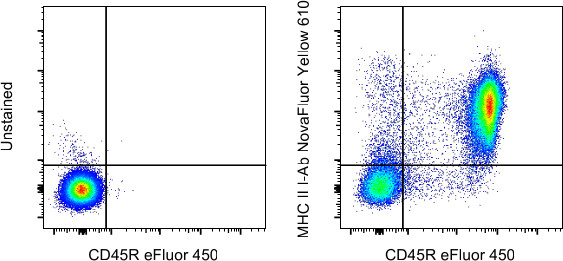Search Thermo Fisher Scientific
Invitrogen
MHC Class II I-Ab Monoclonal Antibody (AF6-120.1), NovaFluor™ Yellow 610, eBioscience™
FIGURE: 1 / 3
MHC Class II I-Ab Antibody (M046T03Y03-A) in Flow



Product Details
M046T03Y03-A
Species Reactivity
Host/Isotype
Class
Type
Clone
Conjugate
Excitation/Emission Max
Form
Concentration
Purification
Storage buffer
Contains
Storage conditions
RRID
Product Specific Information
Description: This AF6-120.1 monoclonal antibody reacts with the mouse MHC Class II I-Ab alloantigen of H-2b bearing mouse strains, including C57Bl/6 and 129. This cell surface molecule is involved in antigen presentation to T cells expressing CD3/TCR and CD4. The AF6-120.1 antibody crossreacts with H-2k and H-2u haplotypes. However, reactivity to other haplotypes (i.e., d, f, g7, p, q, r, and s) has not been observed.
Each product contains 1 vial of NovaFluor conjugate and 1 vial of CellBlox Plus Blocking Buffer .
Applications Reported: This AF6-120.1 antibody has been reported for use in flow cytometric analysis.
Applications Tested: This AF6-120.1 antibody has been tested by flow cytometric analysis of mouse splenocytes. This can be used at less than or equal to 0.6 µg per test. A test is defined as the amount (µg) of antibody that will stain a cell sample in a final volume of 100 µL. Cell number should be determined empirically but can range from 10^5 to 10^8 cells/test. It is recommended that the antibody be carefully titrated for optimal performance in the assay of interest.
NovaFluor dyes are not compatible with DNA intercalating viability dyes. Do not use viability dyes such as propidium iodide, 7-actinomycin D (7-AAD) and DAPI. Invitrogen LIVE/DEAD Fixable Dead Cell stains are recommended for use with NovaFluor dyes.
This NovaFluor conjugate has been updated to ship with CellBlox Plus Blocking Buffer (Cat. No. (C001T06F01)). This buffer contains formulation improvements over CellBlox. CellBlox Plus Blocking Buffer is required for optimal staining with NovaFluor conjugates and should be used in all experiments where NovaFluor conjugates are used. Whenever possible, we recommend adding CellBlox Plus Blocking Buffer to antibody cocktails/master mixes prior to combining with cells. Add 5 µL per sample (regardless of the number of NovaFluors in your panel) to use the antibody cocktail as intended. For single-color controls, use 5 µL of CellBlox Blocking Buffer per 100 µL of cell sample containing 10^3 to 10^8 cells.
NovaFluor conjugates are based on Phiton™ technology utilizing novel nucleic acid dye structures that allow for engineered fluorescent signatures with consideration for spillover and spread impacts. Learn more
Excitation: 552 nm; Emission: 612 nm; Laser: 561 nm (Yellow) Laser
Our internal testing shows that NovaFluor Yellow 610 non-specifically stains B cells in SJL mice. Non-specific staining has not been observed in BALB/c or C57BL/6 mice. Other strains have not been tested. See the Antibody Testing Data for an example of this strain-dependent difference.
Target Information
I-Ab (H2-Ab1, histocompatibility 2, class II antigen A, beta 1) is an MHC class II heterodimer molecule of non-covalently associated alpha (31-34 kDa) and beta (26-29 kDa) chains. Major histocompatibility complex class II antigen presentation requires the participation of lysosomal proteases in two convergent processes. First, the antigens endocytosed by the antigen presenting cells must be broken down into antigenic peptides. Second, class II molecules are synthesized with their peptide-binding site blocked by invariant chain (Ii), and they aquire the capacity to bind antigens only after Ii has been degraded in the compartments where peptides reside. MHC class II molecules present exogenously derived antigen to CD4+ T lymphocytes, which are usually T helper cells. CD4 interacts with non-polymorphic residues of MHC class II. H2-Ab1 heterodimer chains alpha (DQA) and beta (DQB) are both anchored in the membrane. H2-Ab1 plays a central role in the immune system by presenting peptides derived from extracellular proteins. Class II molecules are expressed in antigen presenting cells (APC: B lymphocytes, dendritic cells, macrophages). The beta chain contains 6 exons. Exon one encodes the leader peptide, exons 2 and 3 encode the two extracellular domains, exon 4 encodes the transmembrane domain and exon 5 encodes the cytoplasmic tail. Within the DQ molecule both the alpha chain and the beta chain contain the polymorphisms specifying the peptide binding specificities, resulting in up to 4 different molecules. Typing for polymorphisms is routinely done for bone marrow transplantation.
HLA and MHC antibodies play a significant role in Immunopeptidomics, facilitating the identification and characterization of neoantigens through high-performance liquid chromatography coupled to tandem Mass Spectrometry.
For Research Use Only. Not for use in diagnostic procedures. Not for resale without express authorization.
How to use the Panel Builder
Watch the video to learn how to use the Invitrogen Flow Cytometry Panel Builder to build your next flow cytometry panel in 5 easy steps.
References (0)
Bioinformatics
Protein Aliases: CELIAC1; DADB-249P12.2; H-2 class II histocompatibility antigen, A beta chain; H-2Eb; H2Eb; histocompatibility 2, class II antigen A, beta 1; HLA-DQB; Ia-4; Ia4; IDDM1; major histocompatibility complex class II beta chain; MGC163794; MGC163796; MHC class II antigen A beta; MHC class II H2-IA-beta-psi; response to metastatic cancers 1
Gene Aliases: Abeta; AI845868; H-2Ab; H2-Ab; H2-Ab1; H2-iabeta; I-Abeta; Ia-2; Ia2; IAb; Rmcs1
UniProt ID: (Mouse) P14483
Entrez Gene ID: (Mouse) 14961

Performance Guarantee
If an Invitrogen™ antibody doesn't perform as described on our website or datasheet,we'll replace the product at no cost to you, or provide you with a credit for a future purchase.*
Learn more
We're here to help
Get expert recommendations for common problems or connect directly with an on staff expert for technical assistance related to applications, equipment and general product use.
Contact tech support

